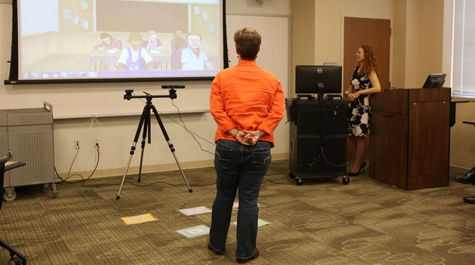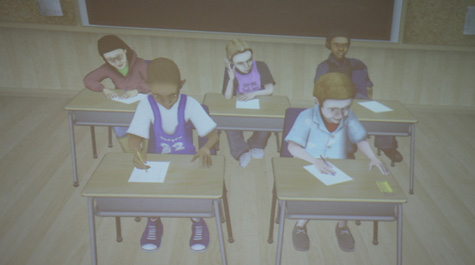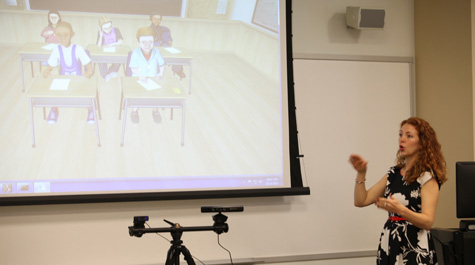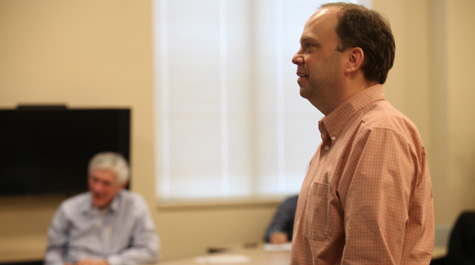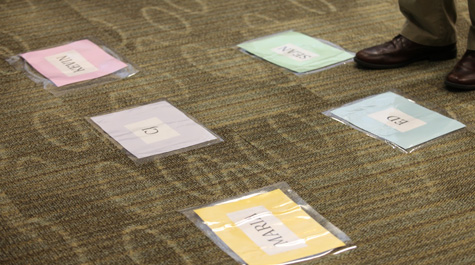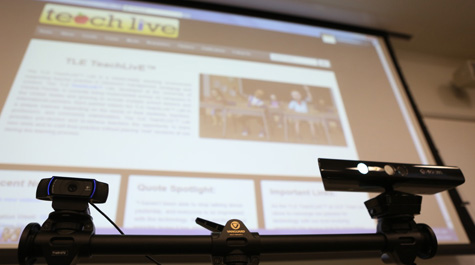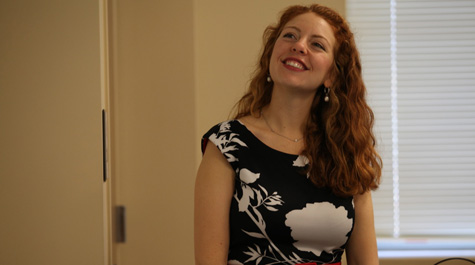TeachLivE at W&M offers teachers classroom simulation
The teacher spots C.J.’s cell phone, and the power struggle begins. The teacher insists the phone be put away; the middle school student crosses her arms defiantly. Voices are raised. C.J. is accused of dishonesty; the teacher, apathy. Finally, the teacher points to the door and orders C.J. out.
It’s a situation that might leave some new teachers shaken, uncertain of whether they handled it correctly and how the confrontation may impact their classroom. But in this scenario, those concerns are assuaged by the knowledge that C.J. isn’t real. She’s an avatar in the TeachLivE™ system, a mixed-reality simulation lab that allows pre- and in-service teachers to get experience in front of a classroom without the pressures and consequences that come with being in front of a live group of students.
{{youtube:medium|eQxfC_a_Wfc, TeachLivE at W&M}}
Developed by the University of Central Florida, the system is being used by students in the William & Mary School of Education for the first time this semester under the guidance of Jackie Rodriguez, an assistant professor of special education.
“The idea is to get them essentially ramped up to a level where they’re not only better teachers but they’re also more confident,” said Rodriguez, “so it increases self-efficacy and it increases the well of knowledge they pull from when they are actually in the traditional classroom.”
Suspended disbelief
At first, the lab in action looks a bit like a large-scale video game. The animated avatars, sitting in a classroom setting, are projected onto a screen, and a session participant stands before them. A camera on a tripod tracks the movements of the participant and allows him or her to virtually walk around the classroom. But, unlike a video game, once the session begins, it’s clear that the avatars aren’t offering programmed or pre-recorded responses. They are reacting in real-time to the participant.
“Students never question whether the classroom is authentic,” Rodriguez said. “They just assume it because [the avatars] are interacting with them synchronously.”
About two weeks prior to a scheduled session, participants must submit a lesson plan and objectives, defining the areas that they’d like to work on – from behavior management to instruction to reaching often-overlooked students. Professors can also select the behavior-escalation level they’d like to encounter on a scale of zero to five, with level five including bullying and personal attacks.
The system offers several simulation options, including middle-school, high-school classrooms, ELL (English Language Learners) classrooms and TeachLivE en Español. The middle school and high school options feature five student avatars from racially, ethnically and linguistically diverse backgrounds. Each of the students – C.J., Ed, Kevin, Maria and Sean – has a distinct personality and can interact not only with the participant but with the other students in the class.
Participants can also opt to interact with an adult avatar, who can represent any number of people, from a parent to a school administrator.
Once the session is over, participants are offered immediate feedback – an after action review – based on their stated objectives.
Practice and performance
The lab is not meant to replace student teaching but augment it, said Rodriguez.
“It’s meant to be a support system and also to be used as an alternative method for practice and performance,” she said.
One of the benefits of practicing in a simulated classroom is that teachers don’t run the risk of botching their initial contact with students, something that can set a negative tone in their classroom for the rest of the year. Similarly, no children are harmed in the virtual environment, Rodriguez said.
“The vice-versa is also true in the sense that students can be very frank and sometimes abrasive and harsh when they are with teachers,” she added.
The lab also allows participants to focus on practicing certain skills. For example, if a teacher does a great job at managing the classroom but needs to work on reaching every student, he or she can request a session that would focus on just that skill – something that’s just not possible in a real classroom environment.
“In my opinion, it’s a perfect antidote for teacher attrition,” said Rodriguez. “If you have a teacher in a classroom who is struggling, generally they are struggling because there is a skill deficit, so why not practice the skill to mastery and support the teacher so that they don’t want to leave.”
First launched in 2004, TeachLivE is currently being used by more than 50 universities across the United States. The use of the system comes at an interesting time in American education, said Rodriguez, as schools face increasing pressure due to high-stakes testing. That pressure can lead school districts to limit how many student teachers are allowed in classrooms and the length of their access.
The lab is another option for students to practice teaching before they are responsible for their first classroom.
Mobile and versatile
With support from the Jessie Ball duPont Fund and School of Education Dean Spencer “Skip” Niles, William & Mary purchased the set-up technology for TeachLivE last year. This semester, Rodriguez and Deborah Ramer, instructor in special education, are using the system with students for the first time as part of a bundled course. Students in that course – which focuses on classroom management, classroom organization, characteristics of exceptionality and adaptations for the classroom – will use the TeachLivE system three times this semester.
But interest in TeachLivE at William & Mary goes beyond curriculum and instruction. Counseling and higher education faculty are also exploring possible uses of the system, from giving students an opportunity to diagnose mental health issues to letting school administrators practice interviewing.
The School of Education has two mobile setups for TeachLivE, which can be moved into any room in the building and, one day, even farther.
“Long-term, the mobility allows us to take it across campus,” said Rodriguez. “Personally and professionally, I’m really invested in supporting educators at all levels. It’s not just about pre-service teachers hitting K-12 students, it’s also about our colleagues -- colleagues who are exceptionally bright and have been experts in their area but have not had access to professional development in pedagogy.”
That professional development is especially important at William & Mary, which highly values the importance of teaching, she added.
“Teaching really matters here, and it’s something that undergirds us as a community, so why not ensure that teachers feel comfortable when they walk into their classes?” Skip to main content
Skip to main content

